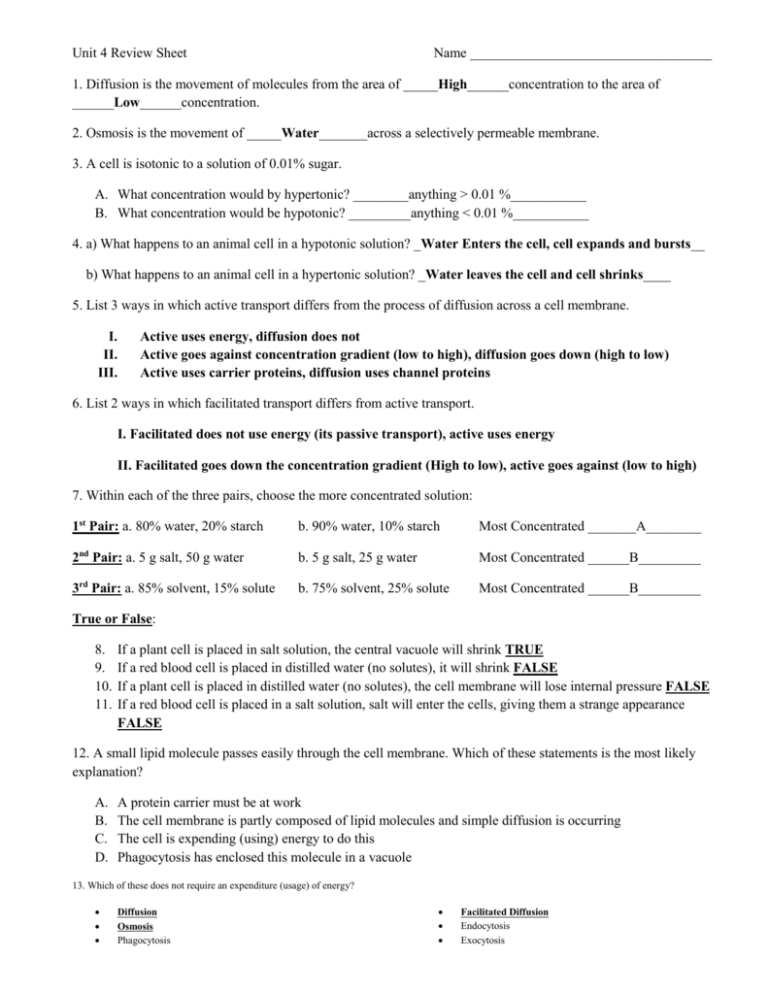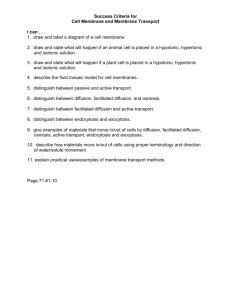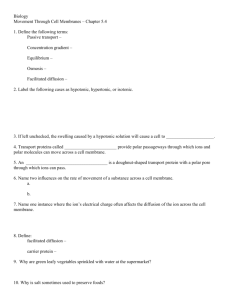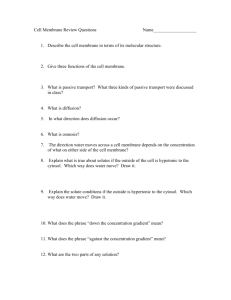Unit 4 Review Sheet Name 1. Diffusion is the movement of
advertisement

Unit 4 Review Sheet Name ___________________________________ 1. Diffusion is the movement of molecules from the area of _____High______concentration to the area of ______Low______concentration. 2. Osmosis is the movement of _____Water_______across a selectively permeable membrane. 3. A cell is isotonic to a solution of 0.01% sugar. A. What concentration would by hypertonic? ________anything > 0.01 %___________ B. What concentration would be hypotonic? _________anything < 0.01 %___________ 4. a) What happens to an animal cell in a hypotonic solution? _Water Enters the cell, cell expands and bursts__ b) What happens to an animal cell in a hypertonic solution? _Water leaves the cell and cell shrinks____ 5. List 3 ways in which active transport differs from the process of diffusion across a cell membrane. I. II. III. Active uses energy, diffusion does not Active goes against concentration gradient (low to high), diffusion goes down (high to low) Active uses carrier proteins, diffusion uses channel proteins 6. List 2 ways in which facilitated transport differs from active transport. I. Facilitated does not use energy (its passive transport), active uses energy II. Facilitated goes down the concentration gradient (High to low), active goes against (low to high) 7. Within each of the three pairs, choose the more concentrated solution: 1st Pair: a. 80% water, 20% starch b. 90% water, 10% starch Most Concentrated _______A________ 2nd Pair: a. 5 g salt, 50 g water b. 5 g salt, 25 g water Most Concentrated ______B_________ 3rd Pair: a. 85% solvent, 15% solute b. 75% solvent, 25% solute Most Concentrated ______B_________ True or False: 8. 9. 10. 11. If a plant cell is placed in salt solution, the central vacuole will shrink TRUE If a red blood cell is placed in distilled water (no solutes), it will shrink FALSE If a plant cell is placed in distilled water (no solutes), the cell membrane will lose internal pressure FALSE If a red blood cell is placed in a salt solution, salt will enter the cells, giving them a strange appearance FALSE 12. A small lipid molecule passes easily through the cell membrane. Which of these statements is the most likely explanation? A. B. C. D. A protein carrier must be at work The cell membrane is partly composed of lipid molecules and simple diffusion is occurring The cell is expending (using) energy to do this Phagocytosis has enclosed this molecule in a vacuole 13. Which of these does not require an expenditure (usage) of energy? Diffusion Osmosis Phagocytosis Facilitated Diffusion Endocytosis Exocytosis 14. The thyroid gland contains a high concentration of iodine. Adding iodine to an area that already has a high concentration would be an example of: A. B. C. D. passive transport active transport facilitated diffusion exocytosis 15. Cell drinking is synonymous with a) cell eating b) endocytosis c) phagocytosis d) pinocytosis 16. Which of the following substances would be taken into a cell by phagocytosis? A. B. C. D. water proteins simple sugars small lipids 17. An animal cell will always take in water when placed in a (n): A. B. C. D. hypertonic solution hypotonic solution isotonic solution active solution Consider the diagram to the right. Note: This is not a cell. 18. Will the concentration of water on side A stay the same, increase, or decrease over time? _____Increase___ Side A Side B 20% Protein 2% Glucose 4% Glucose 75% w ater 98% Water E. membrane 19. Will the concentration of protein on side A stay the same, increase, or decrease over time? __Decrease___ 20. Glucose will cross the membrane in which direction? ___Right to Left_____ 21. What type of transport is being represented by the diagram below? ______Passive (Diffusion)____________ 22. On the same diagram as 21, label the phosphate groups (polar heads) and the fatty acid tails. 22. What molecule helps stabilize the plasma membrane’s fatty acids and keeps it flexible? _______Cholesterol_________ 23. What is a tell-tale sign that the kidneys are failing? _______Protein is found in urine_________________









